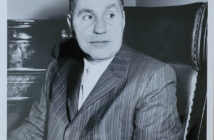As we would exit his car after pulling up near various antique stores, he would go around to his trunk. Inside the trunk of his car he kept a little chest that was always locked. He never let me look inside of it. Some would guess that he might have had a gun inside of the chest, since he was once a young man who started out on the streets of Chicago as a thug back in the 1930s (as a side note, I find it interesting that by the time of his death at age 64, he was an elected official). However, I knew that his gun (as he usually always carried one with him) was either kept under the driver seat of his car or on his person. The gun he often had with him was usually a .38 revolver.
Next to the chest in his trunk he kept a little tote-bag with some mundane things inside, such as a common pair of shoes, a tacky wristwatch and an old Zippo cigarette lighter. He would slip off his Florsheim Royal Imperial Shoes, his expensive watch and his designer cigarette lighter for the old junk in the tote-bag. He even changed his eyeglasses to a lesser quality frame.
But my favorite part of this ritual was that my dad would let me watch him “adjust” his money. My father always carried large amounts of cash in the front left pocket of his western-style Sansabelt pants (I can hardly keep from laughing when I remember my father’s unique taste for fashion). When he would go into that left front pocket of his pants, he would pull out what he would refer to as an “artichoke” – literally a massive bundle of greenbacks. He would always have anywhere from 5-10 thousand dollars on him in cash. I knew he was “carrying light” when his right front pocket was without an artichoke of its own.
He would take his cash and sift through the bills, pulling out a small number of 20s from his pile of mostly 50s, 100s, and, upon occasion, 500s. These 20s were put into a different pile. He had a very expensive adjustable solid gold money clip with a rare antique gold coin mounted in it. The money clip would wrap around even the largest artichokes, but the meager pile of 20s would only get a paper clip or rubber band. The old man never wanted to pull out the artichoke in front of the antique dealers, especially with the gold money clip on it.
This transformation is what he called his way of preventing the antique dealers from charging him more than what he was willing to pay. He explained to me that people in the antique trade try to size-up their customers, assessing their financial capabilities in order to determine what to charge for an item.



